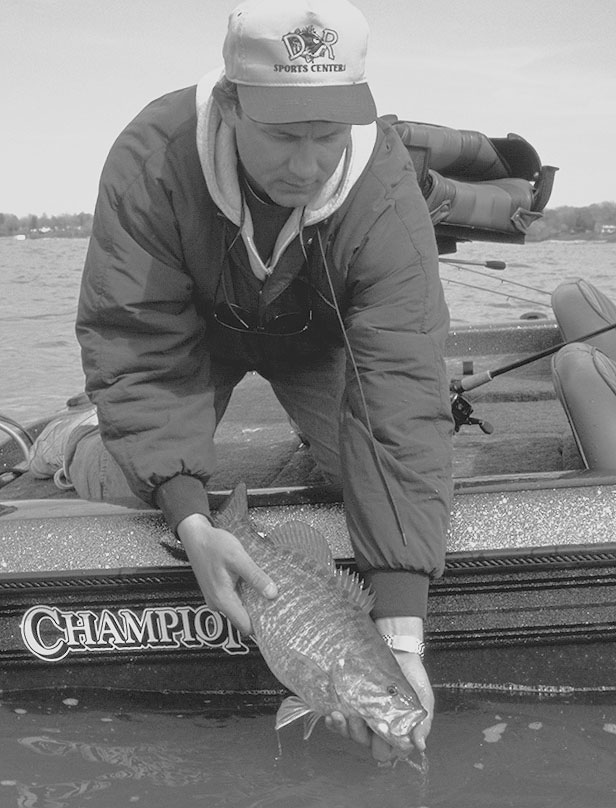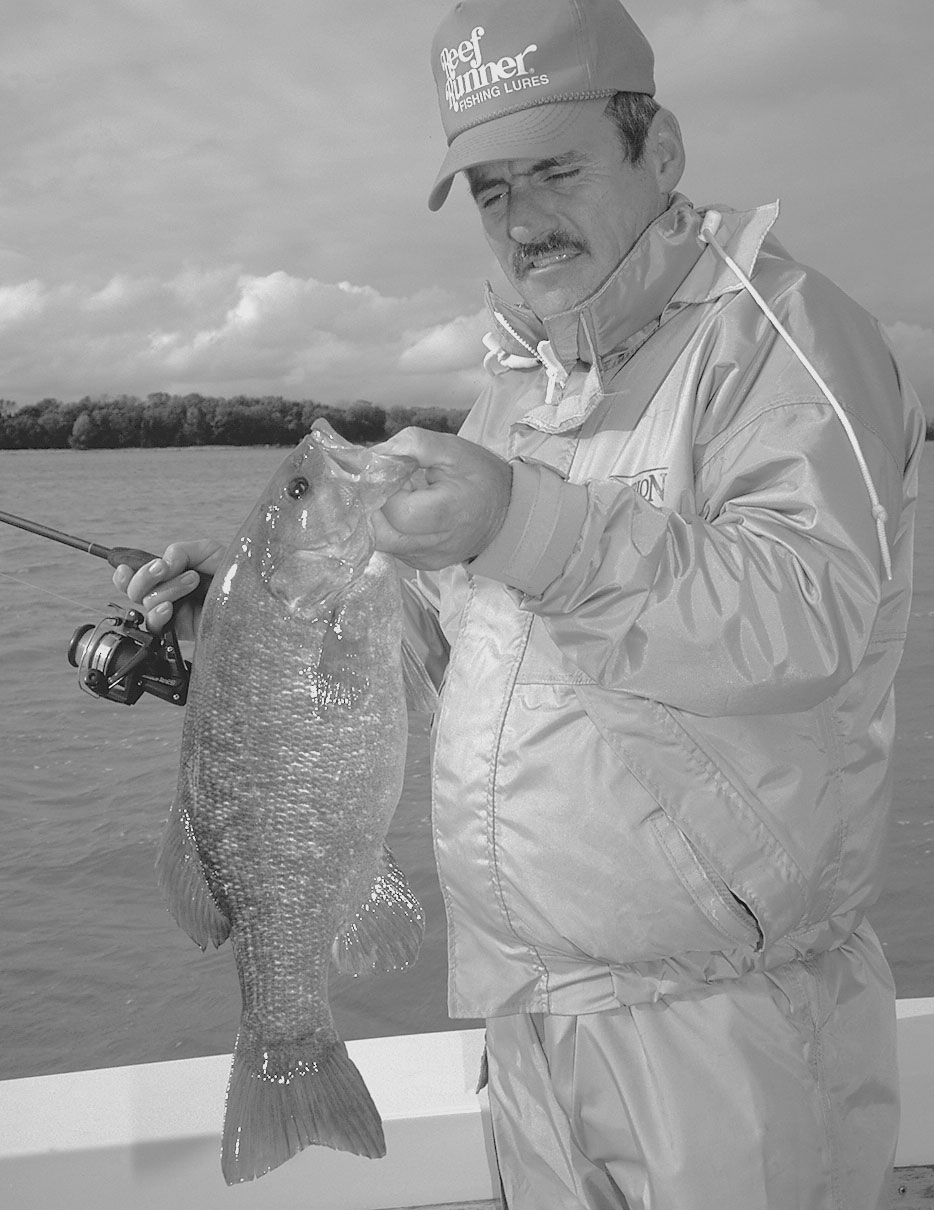 typically takes place in April and early May.
typically takes place in April and early May.Lake Erie's Smallmouths by the Seasons
by Mark Hicks
I
n order to consistently catch Lake Erie smallmouth bass, you must consider their seasonal movements. In a nutshell, smallmouths move up from deep haunts to shallow water as winter gives way to spring. After spawning, they gradually make their way back to deep water where they spend the hot months. Cool fall weather pulls them back up on rocky bottom structures for a final feeding binge before they pull back to deep water with the approach of winter. To catch bass consistently throughout the seasons, you must tune in to
this constant ebb and flow.
bass consistently throughout the seasons, you must tune in to
this constant ebb and flow.
RESIDENT BASS
Throughout much of their range, smallmouth bass tend to be homebodies. They may live their entire lives relating to a large point, an underwater island, or some other bottom structure. No doubt such resident populations of bass exist in Lake Erie. Supporting this view is the fact that specific locations, such as Green Island, have suffered due to intense fishing pressure.
"At one time," says veteran Lake Erie charter captain Jim Fofrich, "Green Island was one of the hottest smallmouth spots in Lake Erieís western basin. Heavy fishing pressure has taken its toll. You still catch bass there, but with diminished frequency."
If Lake Erieís bass roamed as widely as its walleyes, smallmouths from
other areas would continually replenish Green Island. Because overfishing does
undermine resident bass populations, a number of ethical charter captains
encourage their clients to release smallmouths, including Rick Dunlap who
operates out of Midway Marina near Port Clinton, Ohio.
"Meat hogs who want to kill every bass that comes across the gunnel,"
says Dunlap, "donít see my big fish spots. Instead, I take them to places
where they can catch 12- to 15-inch bass. If I let these anglers hammer my
trophy bass, the big fish would soon dry up."
WAYWARD BASS
There also is evidence that some Lake Erie smallmouths do travel widely. During the summer and fall, itís not uncommon for walleye anglers trolling far offshore to catch trophy bass suspended high over mud bottoms. These bass, evidently, follow schools of baitfish out into open water and venture miles from the nearest bottom structure.
Though it is unclear how far Lake Erieís bass roam in search of forage, itís likely they spawn in the same locations year after year. In spring, you can return to known spawning areas and be assured the bass will be there. Though most anglers have little trouble catching Erieís smallmouths at this time, the bass can be perplexing in other seasons.
To stay in touch with bass, you must determine how deep the fish are holding at any given time. This could vary from less than 10 to more than 35 feet. You also need to ascertain how bass are relating to particular structures. Are they up on the tops of humps and flats or hanging on the edges of drop-offs? Are they scattered over large areas or bunched in tight schools? Answer such questions correctly and youíll enjoy fast action with Lake Erie smallmouth bass regardless of the season.
PRESPAWN
Fishing for Lake Erie smallmouth during the prespawn is allowed in Ohio,
Pennsylvania and New York. Michigan and Ontario close their bass seasons at this
time. When spring water temperatures climb into the upper 40s to low 50s
(Fahrenheit), bass stage on the ends of points that extend from spawning areas.
This typically takes place in April and early May.
typically takes place in April and early May.
"Along the Pennsylvania coast," says Pennsylvania fisheries biologist Gary Moore, "you can enjoy good fishing as soon as our trophy smallmouth season opens in mid-April."
Productive depths at this time vary from one basin to the next. In the island area of the western basin, prespawn bass typically stage 17 to 25 feet deep. Central and eastern basin bass are likely to stage 25 to 35 feet deep.
"When New Yorkís trophy bass season opens on the first Saturday in May," says smallmouth ace Jim Hanley, "I start looking for breaks (sharp drop-offs) 30 to 35 feet deep. The bass invariably gang up near a bar, a point or something thatís connected to shore. You wonít find them on offshore humps at this time."
The shore related structures Hanley refers to are rocky bottoms that slope into deep water from the shoreline. In New York and Pennsylvania portions of Lake Erie, such spots are connected to the mainland. In Ohio, productive shore related bottom structures extend from the mainland and the islands. The better structures during the prespawn phase feature points and sharp drop-offs.
"During the early season," says Ohio smallmouth authority Jeff Snyder, "I usually start out fishing drop-offs around the Bass islands and Kelleys Island. I catch some of my biggest bass of the year by vertically jigging 1/2- and 3/4-ounce Cicadas."
The Hopkins 3/4-ounce Shorty spoon is another excellent vertical jigging lure for prespawn smallmouths. Bucktail and tube jigs retrieved slowly over the bottom also do well. Insert 1/4- to 1/2-ounce jigs into tubes, whatever size is necessary to maintain consistent bottom contact. Live bait (soft craws and 3- to 4-inch shiners) also tempt early season bass.
SPAWN
As the water warms, the bass gradually move up to shallower drops and become more active. When the water temperature stabilizes at 55 degrees and above, bass move up to the tops of humps and flats and scatter in preparation for spawning. Spawning depths range from less than 10 to more than 20 feet deep. To a great extent, water clarity determines the most productive depth.
In the shallow western basin, which contains the least clear water, many bass are taken less than 15 feet deep during the peak of the spawn. Youíre likely to find spawning bass deeper in the clearer central basin, and even deeper in the eastern basin, which holds the clearest water. "Here in New York," says Hanley, "I donít catch many bass less than 15 feet deep."
May is the prime month for taking trophy Lake Erie smallmouths as well as big numbers of bass wherever open seasons exist for them. This includes Ohio, Pennsylvania and New York. Michiganís bass season traditionally opens the Saturday before Memorial day. The Ontario bass season opens on the last Saturday in June, which protects all but the latest spawners.
Tube jigs and 5-inch fat grubs paired with football head jigs are essential baits at this time. Cast and retrieve these lures over the bottom, or drag them behind a drifting boat while allowing the breeze to push you along. If the boat moves too fast, use a sea anchor (drift sock) to slow its drifting speed. A Carolina rig matched with a reaper, small plastic worm or curly-tailed grub also fares well.
Drift-and-drag tactics are especially deadly when bass move up on spawning flats. This is time to twitch jerkbaits, as well. When bass see jerkbaits flashing and darting above them in the clear water, they charge up and attack.
In addition to near shore areas, smallmouths move into protected bays to spawn, such as Sandusky Bay in the western basin, Presque Isle Bay in the central basin and the Inner Bay of Long Point Bay in the eastern basin. Though the Inner Bay is off limits to bass anglers at this time, Sandusky Bay and Presque Isle afford good fishing in shallow, relatively sheltered water. If you head for these areas, be sure to bring spinnerbaits and crankbaits, as well as a variety of jigs.
POST-SPAWN &
SUMMERAfter spawning, most smallmouths vacate shallow bays and gradually slide deeper, along with bass that spawned on the main lake. By midsummer, many bass have moved away from shoreline related structures and reside near deep, offshore reefs and humps.
"In June and early July, Iím still catching good fish in shallow water," says Rick Dunlap, a charter captain who concentrates on islands and shoals in U.S. and Canadian waters of the western basin. "Towards the end of July, Iím getting my biggest bass out in 28 to 30 feet of water. My best fishing is in July and August because the bass are schooled tightly then. Everything is predicated on bait. If thereís no bait where youíre fishing, you wonít catch bass."
Dunlapís best big-fish spots are small, subtle structures unrelated to near shore spawning areas. A rise in the bottom of only 1 foot may be enough to hold the bass, particularly if the bottom changes from mud to rock.
"Youíd be surprised," says Dunlap, "by how many bass hold on these isolated areas. Youíve got to put in your time hunting them, but itís worth it because theyíre not pounded to death like the more obvious stuff."
During the early phase of the post-spawn period, Hanley catches a lot of bass from the ends of near shore points. As spring gives way to summer, he checks shoals off shore that comprise the hot weather haunts for smallmouth bass.
"The shoals and humps I fish in the
summertime," says Hanley, "typically lie in 30 to 35 feet of water and top out around 25 feet deep. A few come up to 20 feet. Summer fishing is almost as good as spring, but you donít catch as many bass over 4 pounds."Many of these isolated summertime structures are too small for effective drifting, so precise boat positioning and pinpoint casting pays dividends. Fishing live bait from an anchored boatósoft craws in particularóusually fares better than artificial lures at this time.
FALL
In fall, bass again relate to the points of shoreline structures and often move up on or close to their spawning areas.
"Pay close attention," says Snyder, "to what the baitfish are doing in the fall. In summer and early fall, baitfish usually suspend above the bottom. As the water cools in October, thereís a point when the baitfish suddenly move down and hug bottom. That signals the beginning of some of the yearís best smallmouth fishing."
Tube jigs and jigs dressed with 5-inch fat grubs score well in the fall, as do jigging spoons. As for live bait, shiners do as well as crayfish at this time.